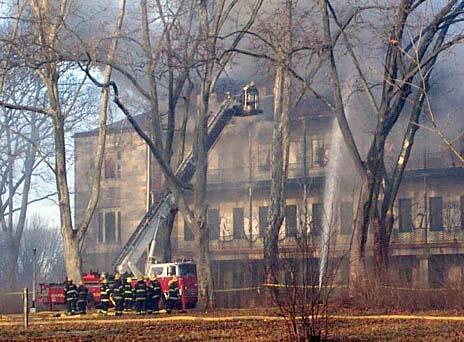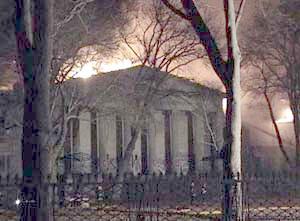Naval Asylum, Philadelphia PA
Watercolor by Augustus Köllner, 1847
Library Company of Philadelphia. Click for
larger image
| The site of the U.S. Naval Asylum in
Philadelphia has had a long and varied history, from a country seat of
pre-Revolutionary Philadelphia gentry to its impending reinvention as luxury
housing.
The 20.7 acre campus at Grays Ferry Avenue served as the Naval Asylum (later called the Naval Home) from the completion of its central building in 1833 to its closing in 1976. It contains three buildings -- the central Biddle Hall flanked by the Surgeon's residence to the left and the Governor's residence to the right -- designed by architect William Strickland and considered one of the best examples of Greek Revival architecture in the country. The site was placed on the National Register of Historic Places and designated a National Historic Landmark in 1971. The collections of PACSCL member libraries are rich in early views and accounts of the buildings. Text and image copied from the PACSCL website. Source - Philadelphia Area Consortium of Special Collections Libraries |

2003
Naval Asylum burns
Philadelphia PA - 3 February 2003
|
this five-alarm blaze that erupted in the early morning hours of February 3, 2003. Preservation experts believe that despite the apparent devastation, much of this National Historic Landmark can be rebuilt. |

|
Links to Historical Photgraphs American
Memory from the Library of Congress U. S. Naval Asylum, Gray's Ferry Avenue, Philadelphia, PA Biddle Hall |
| More info links:
United
States Naval Asylum Philadelphia, Pennsylvania County
of Philadelphia.
Design
for the Naval Asylum in Philadelphia By William Strickland, ca. 1826-33, William Strickland Designs Authorized by Congress in 1811, the Naval Home at Philadelphia was built with money collected from officers and men of the U.S. Navy and Marine Corps at an individual rate of 20 cents a month. By May 26, 1826, the fund was large enough for the Secretary of the Navy to purchase 24 acres of land for $16,000. William Strickland designed the asylum in the Neoclassical style. Stricklandís simple elevation shows square and elongated rectangular windows, a low hipped roof, and restrained use of ornamentation. The asylum was built with cast iron columns to fireproof the structure. Although the cornerstone was laid on April 3, 1827, and the building was completed on December 3, 1833, Strickland signed this drawing in 1844. SOURCE Designs For Democracy 200 years of drawings from the National Archive
More Naval Asylum info... Authorized by an Act of Congress, planned in 1826, the former U. S. Naval Asylum was built c. 1830. It was designed by William Strickland, who also designed the first U.S. Mint, the Tennessee State Capitol, and the cupola for Independence Hall. The facility was used as a naval home and hospital and also, until 1846, as the first Naval Academy. Closed in 1976, it was sold to Toll Brothers - a publicly-traded luxury home builder - in 1981 (settlement was in 1988) for $1,200,000. Since its purchase of the property, Toll Bros. has practiced "demolition by neglect," allowing the historic structure to decline to the point of becoming hazardous in order to receive demolition permits and clear the land for suburban-style development. The City of Philadelphia recently filed a lawsuit charging Toll under its preservation statutes and hopes to receive a court order requiring restoration of the buildings. Biddle Hall, the centerpiece of this magnificent property which is on the National Register of Historic Places and a National Historical Landmark, caught fire in the early morning hours of February 3, 2003 and is now in serious jeopardy. "William Bolger, a National Park Service official who has been tracking the decline of the U.S. Navy's first hospital, calls the 1827 Greek Revival building "the most important endangered work of architecture we have" in the United States." (from "Naval Home is lost only if we let it be" By Inga Saffron Philadelphia Inquirer Architecture Critic) The Naval Home is important for more than its architecture. The property's historic significance goes back to the early formation of the United States when it was part of a parcel owned by William Penn. During the Revolution, when Philadelphia was occupied by the British, it served as home to General Pattison, commander of the Royal Artillery. When the property was sold to the United States government in 1826, it was destined to become a key component in the military hospital system that later gave rise to the modern Veteran's Administration. In 1976 Philadelphia's Naval Home was closed and relocated to Gulfport, MS where it is still in operation. It is considered to be the oldest continuously operating retirement community in the United States. |